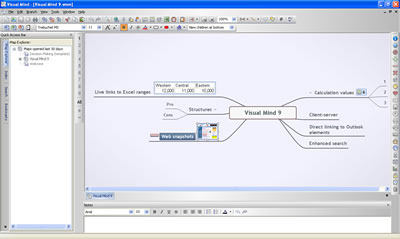 Most of the high-end mind mapping programs have so much functionality that many users don’t realize all that they are capable of. This blog post is the third in a series I’ve been writing, with the help of the software vendors themselves (the previous two were focused on MindManager Pro and NovaMind 4).
Most of the high-end mind mapping programs have so much functionality that many users don’t realize all that they are capable of. This blog post is the third in a series I’ve been writing, with the help of the software vendors themselves (the previous two were focused on MindManager Pro and NovaMind 4).
In this installment, Mattis Oveson from Mind Technologies shares with us a list of little-known, under-appreciated but very useful features that can be found within his firm’s powerful, business-focused mind mapping program, Visual Mind.
1. Print-to-Visual Mind: It is possible to use Visual Mind as your “electronic print basket.” In the same way that you send print jobs to physical printers, you can send print jobs to Visual Mind. This results in a PDF document that you can insert in any location within your mind map. How is this useful? One application is when you need to capture a snapshot of a web page in your mind map. To use this feature, activate the print function of your preferred Windows application (Word, Excel, Web browser etc.), and choose the “Visual Mind printer” as the destination printer.
2. Calculation values: If you are working on estimates, cost calculations and other numerical data, Visual Mind has the ability to automatically calculate the totals for complete sub-trees and maps. To insert a calculation value into a branch, do the following: On the Insert tab, in the Insert group, select Calculation Value. This will bring up a dialog that lets you edit the value properties.
3. Insert structure: In some cases, you may need to enter the same type of information several times. Examples of such information could be contact details, task details or days of a week. To free you from entering the same type of information over and over again, Visual Mind can provide you with “structures” – pre-defined branches and sub-branches that can be inserted into a map at any time. Visual Mind comes with a number of pre-defined structures, and you can compose your own structures for the type of information you frequently use. To insert a predefined structure, do the following: On the Insert tab, in the Structures group, click the Insert Structure button. (editor’s note: This is definitely one of those “why didn’t anyone think of this before?” type of features – extremely useful!)
4. Real-time collaboration: Visual Mind comes with built in client/server functionality. This enables multiple users to share Visual Mind content in real time. Any changes made to a shared map will immediately be made available to other users who are working on the map. This way, Visual Mind offers teams and corporations live information sharing and management via the Visual Mind interface. When a map is shared, all files that are included in the map will also be shared. This means that all users will be able to view and edit the file directly from the map. The Visual Mind server controls that only allow one user to edit a file at a time. If one user has changed the content of a file, the changes will be made available to all other users.
5. Web snapshots: When inserting a web link, Visual Mind can take a snapshot of the actual web page and let the snapshot represent the web link in the map. The snapshot is not much bigger than a standard web icon, but you can resize the snapshot to your preferred size. This capability gives your maps a more appealing appearance. To insert a web snapshot, make sure “show thumbnail image” is enabled when you insert a web link.
6. Phone integration: Visual Mind allows you to make phone calls directly from the software. Visual Mind supports both internet telephony (VoIP) and analog phone calls. The first only requires software (i.e. Skype). The latter requires that you have the necessary hardware connected to your computer. To insert a phone number, do the following: On the Insert tab, in the Insert group, select Phone.
7. Create new documents from within Visual Mind: The program allows you to create new documents (Microsoft Word, Microsoft Excel, etc.) directly from the software. Visual Mind will do everything for you, create the new file, insert a link to it in your map and open the file for you. Visual Mind comes with templates for some common document types (Empty Microsoft Word, Empty Microsoft Excel, etc.), and you can add your own specialized document templates. (editor’s note: This is a practical, time-saving feature. Do you understand what Mattis is saying here? You don’t have to create a Word or Excel document separately, save it and then manually link it into your map. Visual Mind handles all of these steps for you – cool!)
8. Auto-capitalize: Do your topics often start with a capital letter? If yes, the “auto-capitalize” feature in Visual Mind will be useful. Whenever you type in text for a new branch, Visual Mind can automatically capitalize the first letter for you. This is a small feature, but is very handy for certain needs, and it is possible to enable and disable it on the fly.

Leave a Reply